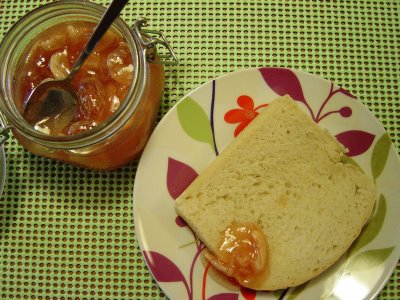
What is it about jam that has charmed me so? It’s a relatively simple thing. It’s not a Plaisir Sucré, a fabulous dessert by Pierre Hermé requiring many steps and much attention. It’s not a soufflé that calls for skill and confidence. It’s jam. Simple. Sweet. Sticky. Sensational.
Have you ever experienced a moment so perfect you wanted to bottle it up and keep it forever? That, for me, is what jam is to fruits (and even some vegetables!). The perfect snapshot of a seasonal treasure. A way of taking what would have otherwise lost its luster in a week sitting at you countertop, and turning it into a jewel that remains brilliant for months to come. That’s magic. That’s jam.
 I have only made jam once before. We have no winter here that requires canning and preserving, so the process was not something I really experienced when I was growing up (except for my grandmother’s & dad’s mango jam…which is amazing and will warrant a separate post someday). After my first brush with jam-making however, I was eager to try it again. I browsed through cookbooks and blogs, finding a lot of scrumptious sounding entries on jams of every kind of berry imaginable. Unfortunately, every kind of berry imaginable does not really grow on my shores. As luck would have it though, a blogging moment of gastronomic serendipity led me to a marvelous post from Marketman about his successful attempts at mangosteen jam.Mmmm…mangosteen. Delicious and tropical, and what’s better, available! Mangosteen is right up there with mangoes in my list of favorite fruits. Their flavor is fantastic! It is described best here and here. Why do I keep looking across oceans for fruits to jam when we have so many gorgeous specimens here? Hmmm…must be something to do with that grass being greener myth…
I have only made jam once before. We have no winter here that requires canning and preserving, so the process was not something I really experienced when I was growing up (except for my grandmother’s & dad’s mango jam…which is amazing and will warrant a separate post someday). After my first brush with jam-making however, I was eager to try it again. I browsed through cookbooks and blogs, finding a lot of scrumptious sounding entries on jams of every kind of berry imaginable. Unfortunately, every kind of berry imaginable does not really grow on my shores. As luck would have it though, a blogging moment of gastronomic serendipity led me to a marvelous post from Marketman about his successful attempts at mangosteen jam.Mmmm…mangosteen. Delicious and tropical, and what’s better, available! Mangosteen is right up there with mangoes in my list of favorite fruits. Their flavor is fantastic! It is described best here and here. Why do I keep looking across oceans for fruits to jam when we have so many gorgeous specimens here? Hmmm…must be something to do with that grass being greener myth…
In any case, I finally attempted it, soon after I saw Marketman’s post, and this is the result. I bought 2 kilos of mangosteens which yielded about 480 grams of fruit. I let this steep for two hours with the same amount of sugar. When the mix turned all liquid-y, I poured it into a heavy bottomed pot and cooked it on medium low, stirring quite often. I cooked it for 60 minutes exactly and what was left filled 2 jars. The texture was perfect. I used the plate-in-freezer test which I think works well and is actually quite fun in my opinion. The color though, as you can see, was a very light blush compared to Marketman’s brilliant burgundy (and compared to the mangosteen jams on the market). I will try cooking it longer next time, although I don’t want to sacrifice any of the texture. Suggestions are welcome! The taste was oh-so-very good and I happily stuck my fingers in the empty pot once it was cool and did a pretty good “pre-clean” ;)Marketman and his readers have already thought up of great ways to use it, and I am happily taking notes. But for now I can say, on toast with a good strong cheese it is sublime.
I've found out the hard way that cooking jam a long time ruins both colour and flavour, especially flavour. The shortest possible time cooking allows the fruit to keep its zingy flavour. Otherwise you get something like soggy, flavourless toffee.
Best thing to make cooking short is keep the fruit at the requisite 105 degrees for the shortest time poss, and use heaps of pectin. Adding lemon zest and the syrup from some pre-boiled lemon seeds is the perfect way to get your jam to set without having to boil all the water off it [to death]. Collecting lemon seeds and pulp left over from recipes is great when you have jam to make- just grab it out of the freezer and boil it and there's your extra pectin.